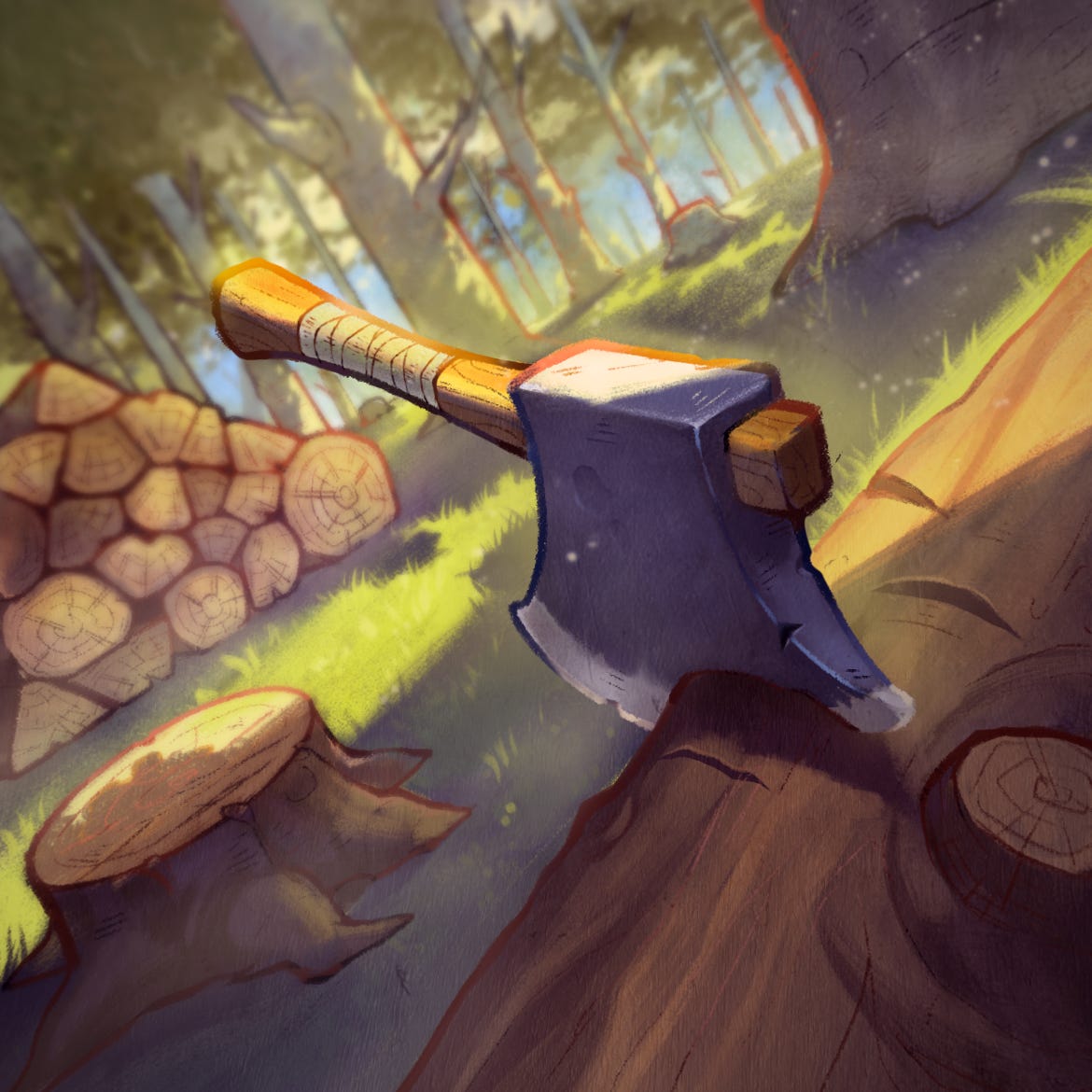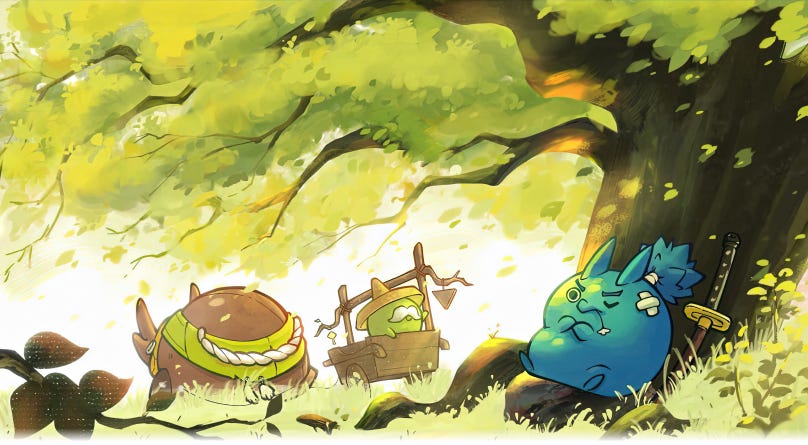
Let’s get down to business. Since the last Homeland release, Trung and I have worked closely together on the development process in a way reminiscent of Axie’s early days, carefully gathering information to guide the way forward.
We have been working with the team to realign development priorities to ensure that community needs and challenges are adequately addressed for the future of the land. We resorted to a familiar mechanism to accomplish this task. Learn more about Discord, the center of Axie conversation around the Land. Getting back into the thick of Discord and chatting with players was both nostalgic and refreshing for us. It should be so.
As Sky Mavis has grown from a small, nimble team of 10 people to a sprawling organization of over 250, the way we build has changed. In some ways this was good. However, this caused us to miss some of the first principles involved in building Axie products.
Naturally, in the early days of Axie, the community was small. The community providing product feedback was much smaller. The Lunasians of 2018 and 2019 were the pioneers here. But it’s 2024 and our community is now much bigger. 180,000 players have played Axie games in the last 30 days. That’s why it’s so important for founders to think critically about their feedback collection mechanisms. While some feedback is actionable and useful, other feedback honestly seems more driven by emotion.

We need to go back to basic Axie building principles. What are they?
Long development schedules and periods between releases are not an issue with web3. This is an experimental technique, so you will need to run a large number of experiments to collect data and feedback from users.
Web3 games differ from traditional games in that community members are involved in development at a much earlier stage and the stakes are higher. Many community members dedicate their lives and meaningful capital to these games. The builder must take this as an unfair advantage.
Axie games can succeed by leveraging social features that increase the number of network connections. Axie is a game that adheres to Metcalfe’s Law: the more people connected to a network, the more valuable the network becomes.
Lunacians are everywhere. It is one of the few interconnected communities that unites established and first-time wealth creators. Players from developed and emerging markets are playing, playing, and building together. This should be reflected in the platforms we release Axie games on. This means that Axie games should be released on mobile (Android + iOS), desktop, and browser whenever possible.
We invented Play to Earn. We are pioneers. What we lack in game design ability we make up for in our ability to show the world things it has never seen before. Here’s a list of things we’re showing the world for the first time (or for the first time on a large scale).
-
Dynamic NFT (2023)
-
NFT Mint released (Origin sale) (2018)
-
Multi-token NFT Mint (Land Sale) (2019)
-
NFT earning ERC-20 (2019)
-
NFT gaming governance token with fee conversion enabled (2020)
-
Airdrop Play (2020)
This makes founders understand that they need to be unusually hands-on and close to the development process compared to more mature industrial/gaming sectors.
The world moves fast. Adapt or die. Even baseball has changed its rules for a new generation.
One of the strengths of our ecosystem, and the unlocking power that NFTs provide, is the ability for NFT collections to act as a wedge into many interrelated experiences. The Axie Core and AXP systems double this. For example, Axie players are encouraged to play a variety of Axie games each day to maximize their AXP gains.
Axie captures your attention and makes you want to learn more. She is friendly and charming. Axie’s infinite combinations enable high-quality UGC.

We had to go back to the core principles of Axie development.
The original vision for Homeland gameplay was a basic construction game that would send axes towards key points on the map (e.g. resource nodes) for combat. We spent a lot of time on basic building elements, but the tires ended up getting stuck in the mud. Base building cannot be a complete game. It wasn’t meant to be, but most of the progress we’ve made so far has been related to this. Here are the issues we gathered while deciding which features to prioritize:
-
Poor cooperative/social skills
-
Development feels slow to the player base.
-
Leaderboards were fun for most experienced players, but the time requirements were prohibitive.
-
Art style/quality issues with 3D Axie models
-
The Adventurer system does not take advantage of axies, which is the benefit of Axie IP.
-
The pace is slow, especially in the early part of the game.
-
Both Moonfall and Moonbeam are off target.
-
The community feels that their feedback is not taken into account.
-
Lunaland has not been released yet
-
Game UX/UI is inefficient and too “clicky”
-
Players believe that the compensating emissions should be higher based on the total budget available.
So the first order of business was to choose a path forward for the current Homeland game. It was actually an interesting process full of possibilities. We were then faced with the need to create an elegant solution to the aforementioned problems and needs without being overly complex or reaching a dead end.
Based on your feedback, we’ve made adjustments to leverage social coordination and combat features to allow Homeland to be a social strategy game with both PvP and PvE elements.
The key requirements we stated to the Homeland team were:
-
Homeland is fun to play and allows social cooperation/competition/war.
-
Playing a land is more than just mindlessly harvesting rewards.
-
Skills-based rewards are easy to understand and make sense.
-
Update releases are conducted quickly and iteratively based on data and player feedback.
-
It is much better to under-promise and over-deliver.
-
Opening gameplay should be much faster
-
Reduce clicks and improve UX
Let’s talk about war.
War games with elements of time and space have been proven to balance real money economies. Creation and destruction must be balanced.
This is evident through games like Eve Online, whose founder Hilmar is a fan of Axie. He said, “Everything I say about Axie now, I said about Eve back then, when it was a mining game without war. ” This is an interesting revelation. For the first eight years, Eve really only played mining/gathering games. There was no war and people did not fully understand it.
Sound familiar? Gathering and crafting are of utmost importance as they allow the accumulation of resources towards a final end goal or synchronization. Creation and destruction.
Many components for a wargame exist in the game today, you just need to put them together in the right flow.
The road to Homeland involves two parallel routes. The first and most important thing is to add social, competitive, and war elements to Homeland. You can think of this as building a new game on top of Homeland, while using some of the existing building blocks as a sort of “map editor”.
The second track involves improving, rethinking, and removing aspects of the existing game.
Let’s go into the first track.
It’s low hanging fruit. From the beginning, adventurers were always going to be replaced by axes. After the recent NFT axie integration this became possible.
A revised system featuring axes will open up both strategic PvE and PvP experiences. We envision players being able to “send” or target places of interest on the map. This could be a resource node or another player’s plot. The player can then send the ax to attack this spot. Combat is mostly passive, but we’re looking into adding more active elements over time. This is very similar to the original vision for athletics gameplay.
Plot specialization will be further strengthened with the opening of a new specialization path, Combat.
PvP may focus on disabling other players’ buildings as players fight to build power and control limited points of interest, such as resource nodes. Of course, this paves the way for the guild to take a prominent position in Homeland.
Many of you were fascinated by the 2020 Project K demo’s ability to move around with axes, meet other players, and have impromptu gatherings in public spaces. We loved it, and we agree that right now Homeland can feel like a solitary experience that doesn’t serve the community that is our superpower.
First, we’ll be adding the ability for players to explore using their own axes. Imagine this:
-
Choosing an axie as your controllable avatar
-
Use your mouse and keypad to move around in an isometric camera view (like in Diablo).
-
Use your avatar to visit other landowners’ lots.
-
Visit public places to meet other avatar axes.
-
Chat with others through proximity chat
-
Participate in mini games such as fishing on public land
We are also exploring a user flow where anyone can create an avatar using one of our NFT axes and join Homeland. We’ve seen the success of Pixel’s free-to-play onboarding for non-landowners and believe a similar path to accessible play could work well for Homeland.
This week, AXP launched in Homeland. Now your axies can earn AXP by collecting, crafting, producing, upgrading structures, and more!
We will also integrate AXP into the NFT axie Adventure system once distribution is complete.
We will adjust our AXP gain rates based on feedback and data generated from production. For example, adjustments are made when we determine that the AXP for a particular action is higher than expected or lower than warranted based on the difficulty of the task compared to other actions.
Trung, the team, and I understand the pain over Moonfall and Moonbeam. We believe there is an elegant solution here.
Every day, players will encounter different quests. Completing this quest will earn you chests and tickets, as well as opening up opportunities for rewards.
Quests change daily but follow familiar instructions. Each core aspect of the game – collecting, producing, crafting, and adventuring – boasts its own unique challenges. Within this set, players will encounter three levels of quests. Low Effort, achievable through standard gameplay; High effort requiring more time and dedication; A luck-based quest where the outcome depends on chance. Each tier offers a varying number of chests as rewards.
We’ll also be bringing back leaderboards, which were well-received during the alpha period despite their rough and intense nature. To ease the intensity and allow Homeland players to sleep, these leaderboards focus on specific actions and have time constraints.
This article briefly described short-term routes across the country. Based on the feedback and responses in this release, we’ll be doubling down on what works and deleting what doesn’t.
Based on your feedback, we’ve dramatically shortened the timeline and priorities for social features and ax-based combat.
We believe that the mechanics described today leverage Homeland’s unique strengths and the components it has built so far. This allows you to quickly test and adjust.
In the meantime, please continue to provide feedback through the land forums in the Homeland Thread on Discord + Artic in the contributor forums.
Jeff, Trung and Founders

